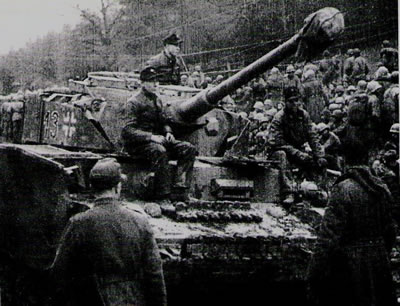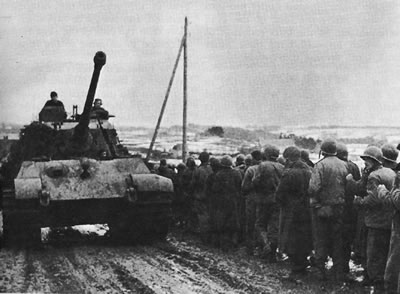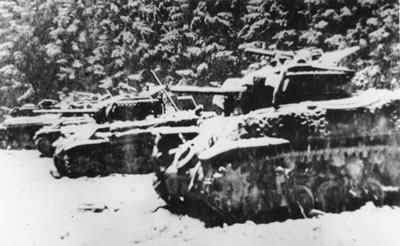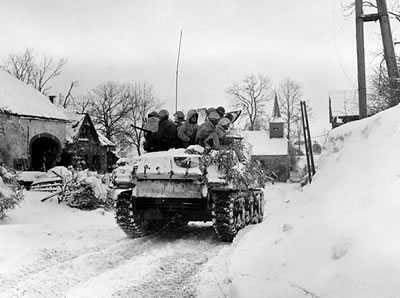The Battle of the Bulge, also known as the Ardennes Offensive, was Germany’s last great tank offensive in World War II and the largest combat action in US military history.
It took place in the Ardennes Forest in France, Luxembourg and Belgium and lasted from December 16, 1944 to January 25, 1945.
The name “Battle of the Bulge” came from the shape of the German salient in Allied territory.
Germany’s King Tiger tank (the Tiger 2) is mostly remembered for its activity at the Battle of the Bulge. However, the King Tiger had already seen some action at the Battle of Arnhem, in the Netherlands, that September.
The Plan
 At the end of 1944, Allied forces were moving toward western Germany.
At the end of 1944, Allied forces were moving toward western Germany.
The Battle of the Bulge was the result of a plan, conceived by Hitler, to stop the Allied advance and achieve total victory in Western Europe, thus freeing up all Germany’s resources for use on the Eastern Front.
Hitler wanted his troops to break through a weak sector in the Allied line and then move on the port the port city of Antwerp, Belgium, which the Allies were using as a supply base. The German’s would annihilate Allied troops all along the way.
The German action would cause the Allied supply line to be cut off and American and British forces to become be separated. Ultimately, the Allies fighting on the Western Front would surrender.
Senior German officers warned Hitler that his plan could succeed – there were not enough German troops available for the campaign to be successful. They recommended a smaller, less ambitious assault. However, Hitler would not listen to them.
The Battle
The attack took place in the Ardennes, where Allied defenses had been thinned. An 80 mile front was being held by just six US divisions, which consisted mostly of soldiers that either had no combat experience or had experience in combat, but were recuperating from earlier battles.
Early in the morning of December 16, 1944, the Germans launched a surprise assault.
At the start of the battle, the Germans clearly had the upper hand.
They had intentionally attacked when the weather was poor. Allied planes had been grounded and observation was limited.
The Germans intentionally spread confusion among the American by planting English-speaking soldiers in American uniforms behind Allied lines. These English-speaking Germans cut phone lines, changed road signs and gave incorrect directions.
 The Germans also had the advantage of numbers. German forces at the start of the battle included about 200,000 men, 1,900 guns, and 600 tanks and other tracked vehicles. German panzers included Panzer IVs, Panthers, Tiger 1s and Tiger 2s.
The Germans also had the advantage of numbers. German forces at the start of the battle included about 200,000 men, 1,900 guns, and 600 tanks and other tracked vehicles. German panzers included Panzer IVs, Panthers, Tiger 1s and Tiger 2s.
On the other hand, the Americans had only about 80,000 men, 400 guns and about 400 AFVs, including about 240 Sherman tanks.
On December 17, the second day of battle, in the town of Malmedy, Belgium between 90 and 130 Americans from the 285th Field Artillery Observation Battalion were captured by members of the 6th Panzer Army. The Germans then lined the Americans up and shot them. Some of the Americans were able to escape. Of these, some hid in a nearby cafe. The Germans set the cafe on fire and then shot the men as they ran out to escape the flames.
Despite the German advantage, isolated American units were able to hold out, giving the Americans and the British a chance to send reinforcements.
In the north, the First and Ninth armies moved toward the German’s northern flank.
General Patton’s Third Army advanced from the South.
The British sent reinforcements to support the line at the Meuse River, which was on the way to Antwerp. The British were equipped with Sherman Fireflies.
 Allied troops also included contingents from Canada, France, the Free Belgian Forces and the Luxembourg Resistance.
Allied troops also included contingents from Canada, France, the Free Belgian Forces and the Luxembourg Resistance.
The US 7th Armored Division was able to stop a German advance from St. Vith, Belgium toward the Meuse, and the US 101st Airborne Division was able to prevent the 5th Panzer Army from reaching the town of Bastogne, an important hub where seven major roads converged.
Meanwhile, the Germans had surrounded American troops in the town of Bastogne. On December 22, the Americans at Bastogne, who were hugely outnumbered, were given an order to surrender. This is when Brigadier General Anthony C. McAuliffe, commander of the US 101st Airborne Division, issued his famous reply to the German commander: “Nuts.”
On December 23, the 5th Panzer Army took St. Vith, but they were stopped by the US 2nd Armored Division before they were able to reach the Meuse.
The US 4th Armored Division reached Bastogne on December 26.
On January 3, 1945, the Allies launched an offensive.
The King Tiger
The King Tiger was a deadly tank and very hard to knock out.
However, Tigers were not very mobile and was not well suited for fighting in the dense forest of Ardennes. They needed Panzer IV and Panther tanks to clear the way for them.
More importantly, King Tigers used up fuel very quickly, and the Germans did not have much fuel to begin with.
In fact, they launched the attack with much less fuel than they would actually have needed to carry out Hitler’s plan.
The Germans had planned to deal with this problem by using fuel captured from the Americans.
 In battle, if a King Tiger ran out of fuel, the tank crew would often simply abandon it.
In battle, if a King Tiger ran out of fuel, the tank crew would often simply abandon it.
The German assault came to a standstill as the result of a lack of supplies, particularly tank fuel.
Allied Victory
By January 16, the US troops had closed off the front end of the salient, leaving the Germans with no way to escape
On January 25, 1945, the German offensive ended.
The Allies had taken back all of their lost ground.
By the end of the Battle of the Bulge, the Americans suffered 80, 00 to 90,000 casualties, the British about 1,500 and the Germans between 80,000 and 100,000.
Approximately 800 Allied tanks were lost; the Germans lost about 600 tanks and assault guns.